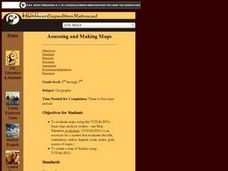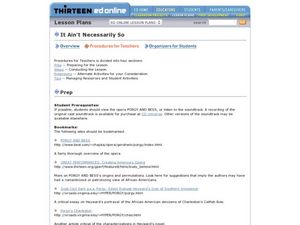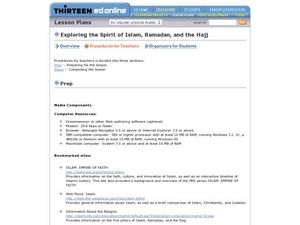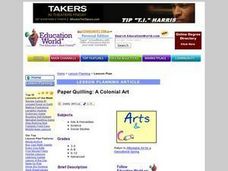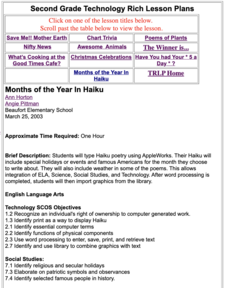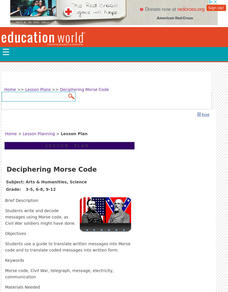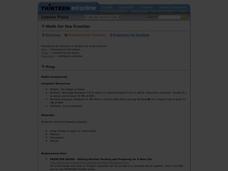Curated OER
What Do We Learn From the Repartiation of Alaska Native Artifacts?
Students observe and evaluate evidence of Alaska Native cultural symbols and artifacts. They research historical data from a variety of primary resources, including the Harriman expedition journals, related web sites, oral accounts,...
PBS
Predicting/Making a Hypothesis
Students analyze information from a variety of sources in order to create a hypothesis about the origin of an interesting family artifact.They create alternative hypotheses based upon available information to demonstrate that some...
Curated OER
Can We Be Both Conservationists and Consumers?
Students explore their role as consumers and conservationists and what roles they play in today's economic climate. They explore resource allocation issues. Students analyze data and draw comparisons between historical and present-day...
Curated OER
How Has Transportation Changed Since the 1899 Harriman Alaska Expedition?
Students recognize modes of transportation. They research historical data from a variety of primary and secondary sources including the Harriman expedition journals, related web sites, and photographs from the expedition. Students...
Curated OER
Learning About Location: Charting the Path of the George W. Elder
Young scholars acquire a working knowledge of the geographical concepts: absolute location, relative location, longitude and latitude. They analyze primary sources that shows the physical and human characteristics of the places along...
Curated OER
Assessing and Making Maps
Students evaluate maps using the TODALSIGs basic map analysis system, explained on the worksheet. They create a map of Alaska using TODALSIGs. Students brainstorm the elements of maps.
Curated OER
Changing of the Guard
Students reflect on their knowledge of democracy. After reading an article, they examine current plans for the placement of a democracy in Iraq. In groups, they research past regime changes and democratization attempts and discuss the...
Curated OER
Motherhood Math: Mothers in the Workforce
Students evaluate a table showing how the number of working mothers increased between 1955 and 2000. They use the information from the table to complete a worksheet imbedded in this lesson.
Curated OER
It Ain't Necessarily So
Students examine characterization of African Americans in literature, popular culture, and opera. In this stereotypes lessons, students conduct research that requires them to analyze the origins and content of stereotypes perpetuated...
Curated OER
Exploring the Spirit of Islam, Ramadan, and the Hajj
Ninth graders explore the different ways people celebrate their religions. In this Religion lesson, 9th graders examine the basics of Islam. Students create a handout on a specific topic about Islam.
Curated OER
Genocide, Sovereignty, Humanitarian Intervention and Accountability
Twelfth graders examine the attempts by various countries to genocide their members. In groups, they compare and contrast the responses by the other countries of the world to stop the genocide. They also identify cases in which the...
Curated OER
Getting Here from There
Students role-play early 20th century immigrants on their way to Indiana. They consider the methods of travel available to them and write a letter to a friend outlining their travel plans and adventures during the trip.
Curated OER
Civilizations of the Americas
Study and compare multiple aspects of both Aztec and Inca civilizations. Young historians explain how each of the empires came to be, and how they were both defeated by the Spanish. The resource starts out as a good lesson, but is...
Curated OER
Incredible Shrinking Notes
Young scholars listen to a biography of Amelia Earhart. They fill in an index card of the important information. They narrow down those notes to smaller post-it notes. They practice determining important facts in documents.
Curated OER
ESL Integrated Literature Unit
Students read and analyze information related to the book Island of the Blue Dolphin. They select appropriate information for the purpose of investigating part of the book.
Curated OER
"De Colores"
First graders learn color words in Spanish through the use of a song. In this Spanish music lesson plan, 1st graders sing the song "De Colores" to help them learn their color words in Spanish.
Curated OER
Ten Characters from American Folklore
Pupils read short stories about ten characters from American folklore. They match a statement about each character with the correct character. They then rewrite one of the ten stories in their own words (optional).
Curated OER
Units and Measurement
Learners discuss the word weight, how much they weigh and the conccept of heavy and light. They hear the story of measurement and the metric system. They work in groups and measure and record items found in the classroom and use a...
Curated OER
Paper Quilling: A Colonial Art
Students discover the art of paper quilling and rolled paper. As a class, they identify patterns and forms found in nature. They create their own piece of quilled art and view their classmates creations as well.
Curated OER
Months of the Year In Haiku
Students type Haiku poetry using AppleWorks, including special holidays or events and famous Americans for the month about which they choose to write.
Curated OER
Deciphering Morse Code
Students write and decode messages using Morse code, as Civil War soldiers might have done. They use a worksheet imbedded in this activity to help them experience morse code.
Curated OER
Mississippi River Scavenger Hunt
Students explore print and online resources to explore the Mississippi River and then use the information to complete a scavenger hunt.
Curated OER
The Halifax Explosion: Who Was Responsible?
Students investigate who or what was most responsible for the tragedy of the Halifax Explosion.
Curated OER
Math for the Frontier
Students explore the concept of inflation. In this inflation instructional activity, students compile a list of necessities they would need to take with them if they were moving to a new state next month. Students compare their list...







